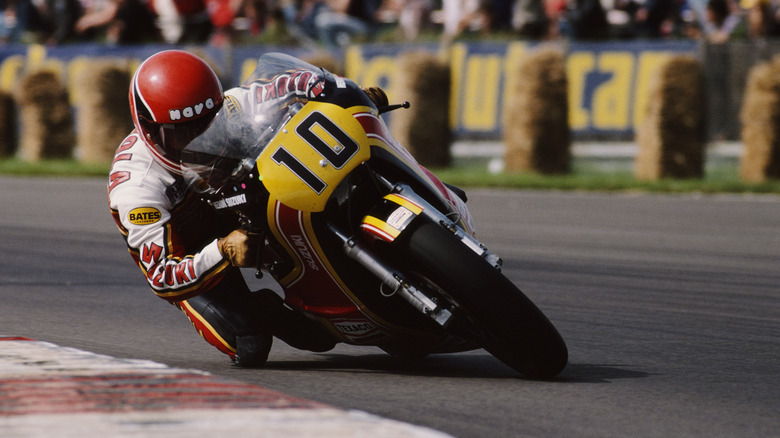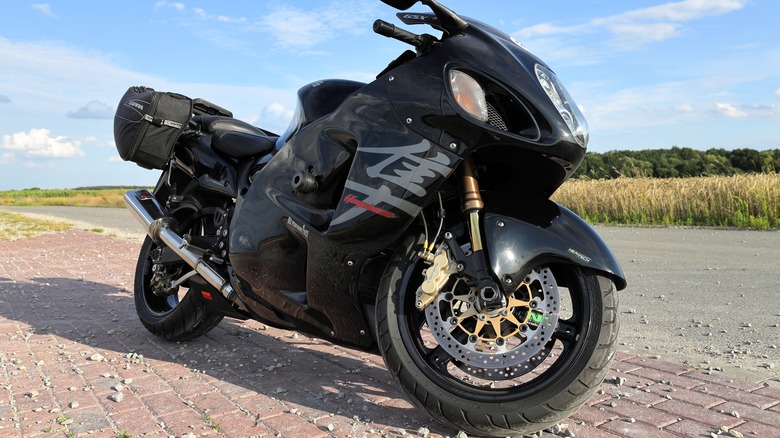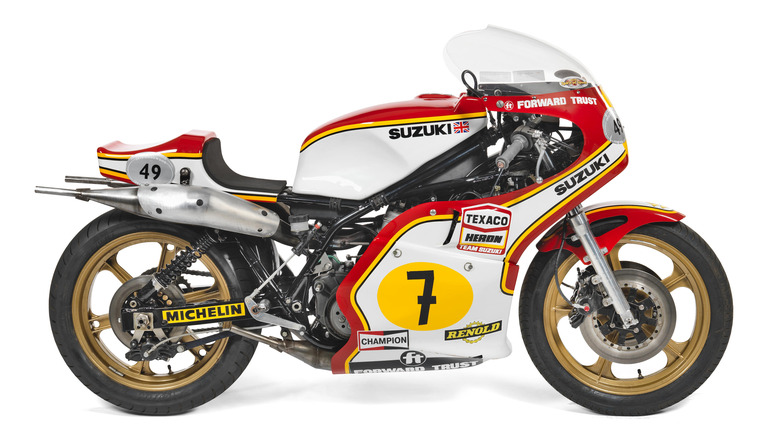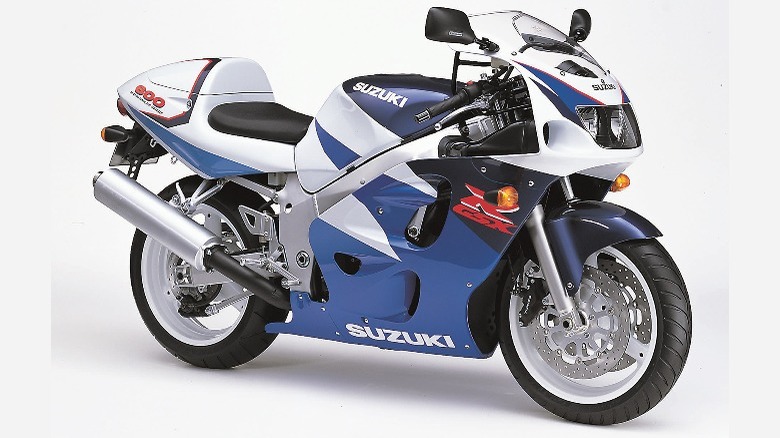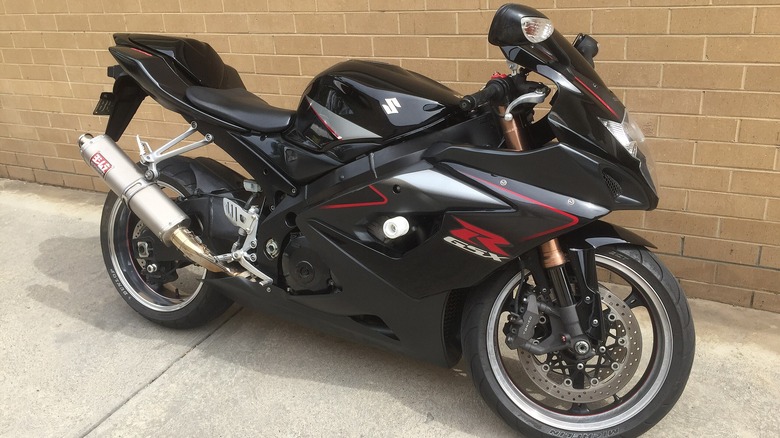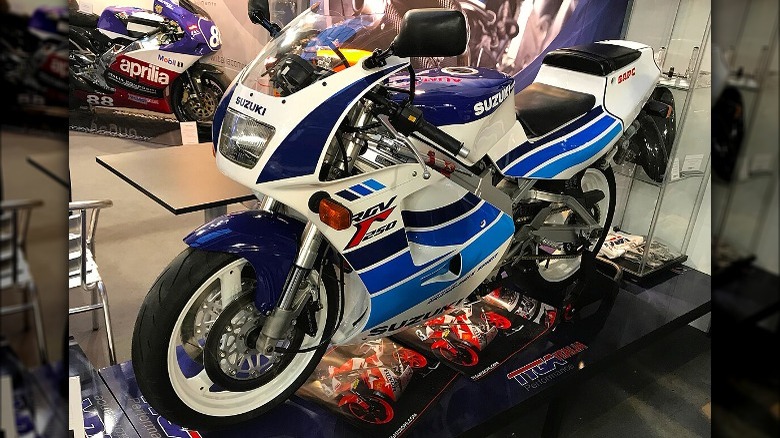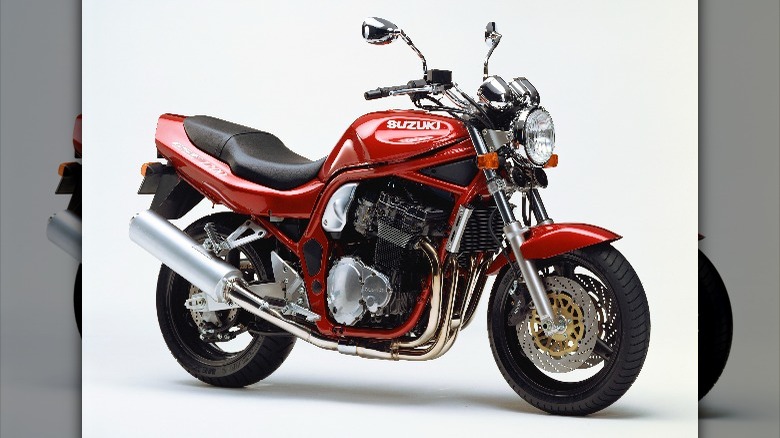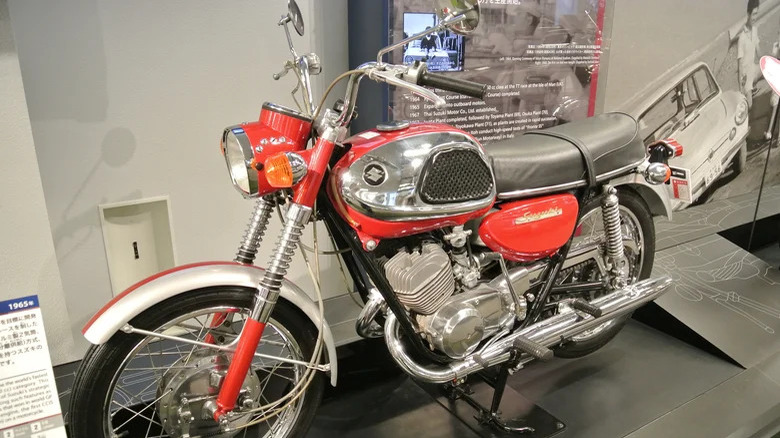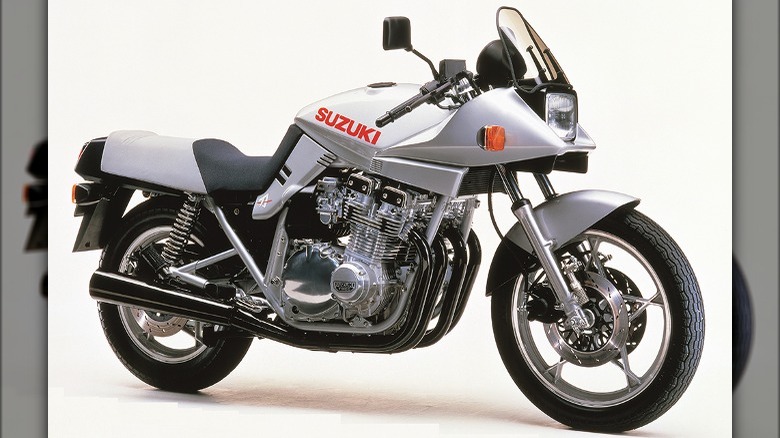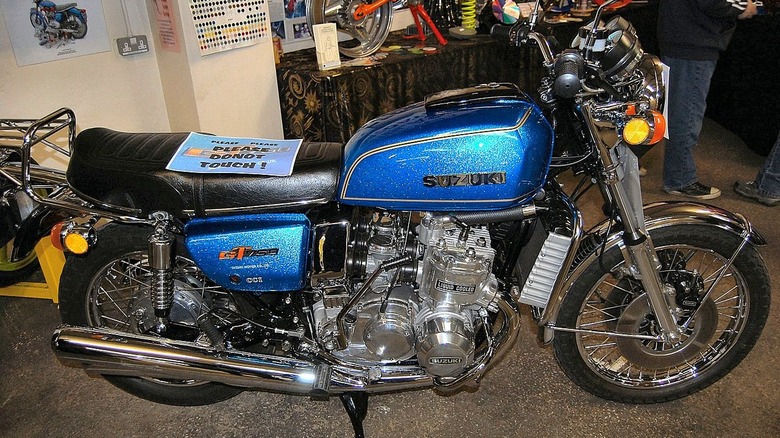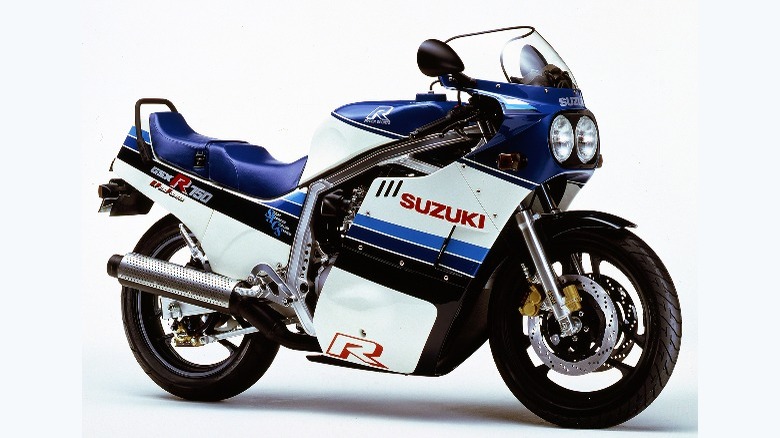10 Of The Most Successful Suzuki Motorcycles In History
Suzuki has been manufacturing motorcycles since 1952, when it unveiled the Power Free, a bicycle with a one horsepower motor attached. In the next few decades, Suzuki would rapidly rise from being an unknown name into one of the biggest in Japanese motorcycle manufacturing, churning out many segment defining models and building a fanbase that spanned the globe. Many of its bestselling nameplates boasted remarkable longevity, spanning several decades of production and, in some cases, are still being built today.
It has made many excellent machines over the years, but a few of Suzuki's models stand out as being particularly successful. Success is defined here as a combination of performance, sales, and cultural/technical impact on motorcycling. This includes both road and race oriented motorcycles, with many of the brand's top models proving successful in both arenas. Whether they're treasured icons or overlooked gems from the company's past, these Suzukis are among the brand's biggest successes to date.
Suzuki GSX1300R Hayabusa
The original Hayabusa stunned buyers and critics alike when it was unveiled in 1999. It was not only faster than any Suzuki motorcycle before it, but also usable at everyday speeds. Its acceleration remained unflinchingly rapid all the way up to the motorcycle's top speed, which was calculated by testers to be almost 200 mph. Its 1300cc engine churned out over 170 horsepower, although aftermarket parts could push that figure significantly higher.
The Hayabusa proved to be a success in terms of sales as well as being groundbreakingly fast, with Suzuki selling almost 190,000 examples across the first and second generations of the bike. It's now in its third generation after a quarter of a century of production, but that would never have been possible were it not for the success of the original. Few motorcycles can claim to have invented an entire segment as Suzuki did with the Hayabusa — the Ultimate Sport segment — and even fewer motorcycles can claim to have pushed the limits of road-going motorcycle performance quite so dramatically in the process.
Suzuki RG500
An instrumental motorcycle in establishing Suzuki as a world class racing manufacturer, the RG500 was developed by a very small team but would prove dominant for years in 500cc racing. Its two-stroke, square-four engine was unlike anything else seen on track at the time, but proved so successful that eventually other manufacturers copied Suzuki's design. The RG500 XR14 gave Suzuki its first taste of top-level success, with Barry Sheene winning Suzuki its first grand prix in 1974.
Two years later, Sheene helped Suzuki claim its maiden manufacturers' title, which gave brand bosses an idea. The RG500 was still the fastest motorcycle on the track, so why not give privateers the chance to ride one? Doing so would not only prove Suzuki's dominance but also increase its chances of keeping its manufacturers' crown. So, the decision was made to sell works-grade bikes to any rider with the funds and talent to justify one.
The experiment was very successful, and Suzuki would end up with seven consecutive manufacturers' titles as a result. Today, these racing icons are highly sought after among collectors, with works bikes particularly prized. One example appeared at a Bonhams auction in 2016 with a sale estimate of £45,000-£55,000 (around $61,000-$75,000 at the time).
Suzuki GSX-R600
The Suzuki GSX-R600 proved a success both on the road and on the track, with a high-revving engine that was best enjoyed at full throttle. It was introduced for the 1997 model year and shared much in common with the larger GSX-R750. It was a significant improvement over Suzuki's previous 600cc bikes and proved to be among the best in its segment, finding favor with buyers looking for an affordable bike to push to its limits. As a result, many examples were used and abused over the years, although arguably that's exactly how Suzuki intended.
As well as being successful in road-going form, the GSX-R600 also won the Japanese manufacturer two World Supersport Championship drivers' titles. Later generations of the bike added iterative improvements, but like many Suzuki motorcycles, the brand saw no need to reinvent what was already a class leader, and so few major revisions were ever made.
Suzuki GSX-R1000 K5
The K5 is considered to be the ultimate iteration of the GSX-R1000, which was first launched in 2001. The K5 was launched in 2005 and boasted improved performance and looks, but make no mistake, the original GSX-R1000 was already a fearsome motorcycle. Competing against Yamaha in the rapidly evolving 1,000cc segment, the first iteration of the bike represented a leap forwards in performance, pushing Suzuki to the forefront of the pack.
The K5 was simply an improvement of what already made the GSX-R1000 an excellent bike, with over 170 horsepower on tap and the ability to reach speeds well north of 180 mph. All that without any real driver aids or onboard computers getting in the way. The K5 also tweaked the styling of the GSX-R1000, with slightly sleeker looks than before. Its main appeal, however, was always its performance, with a combination of high power and light weight that some would argue any 1,000cc Suzuki has yet to better.
[Featured image by Ernos5 via Wikimedia Commons | Cropped and scaled | CC BY-SA 4.0]
Suzuki RGV250
A slimmed-down version of the RGV500 that was causing a storm in Grand Prix racing, the RGV250 that launched in 1987 was one of the sharpest and fastest bikes in its segment at the time. Its 55 horsepower isn't a huge figure by today's standards, but given the bike's light weight, it was still plenty to make the RGV250 a thrill on the roads. Its lean angle was also highly unusual for a road bike, at 58 degrees, again a product of its racing heritage.
The bike was popular with buyers at the time of its release and it has retained a fan club today, although since it was never officially sold in America, it's still a rare sight. A few examples have made their way over as imports, but it's Europe and Japan where the RGV250 has made the most impact. A lightweight, straightforward, and powerful bike, owners today will be just as happy to attest to its talents as they were back in the '80s.
[Featured image by AlbertoSossella via Wikimedia Commons | Cropped and scaled | CC BY-SA 4.0]
Suzuki GSF1200 Bandit
Giving buyers more of what they were asking for — chiefly, power — without making them pay for anything they weren't, the Suzuki GSF1200 Bandit followed the classic muscle formula. It was a straightforward motorcycle with a surprisingly potent engine, but it still retained enough manners to make it usable as a commuter. Like most of Suzuki's great motorcycles, the Bandit 1200's lack of electronic aids was a selling point both at the time of its release and today, giving riders a more analog experience.
The Bandit line had been around since 1989, but the Bandit 1200 wasn't introduced until 1996. It soldiered on for another decade until it was replaced by the Bandit 1250, which was water-cooled rather than being air and oil-cooled like the 1200. Out of the whole Bandit line, it was arguably the 1200 that was the most successful, being both a commercial hit and also offering a highly modifiable platform with which tuners could improve its already impressive performance.
Suzuki T20 Super Six
In Suzuki's earliest days as a motorcycle manufacturer, it struggled to make a name for itself outside of its native Japan. In general, Japanese motorcycle manufacturers were seen as inferior, but the T20 Super Six helped change that notion. The 250cc bike, introduced in 1966, was both quick and comfortable, and helped give Suzuki a foothold in international markets for the first time.
The bike's 29 horsepower output was still on the modest side, but thanks to its light weight and simple construction, its performance and handling was on par with the best in the segment at the time. It would later demonstrate its talents in competition, making an impression with racers across Europe and entering prestigious races like the Isle of Man TT. Ex-racing examples have retained a small but enthusiastic fanbase but only very occasionally appear for auction or private sale. As well as being a successful model, it's arguably one of Suzuki's best looking motorcycles to date.
[Featured image by Rainmaker47 via Wikimedia Commons | Cropped and scaled | CC BY-SA 3.0]
Suzuki GSX-S1100S Katana
A design milestone in sportbike history and a catalyst for years of forward-thinking development at Suzuki, the original Katana looked unlike any other bike before it. It was based on Suzuki's existing GS1100 but featured the input of Target Design, a German design firm run by a former BMW chief of styling. Suzuki gave very little styling direction to the firm, which allowed the designers to come up with a completely fresh design that reimagined what a Japanese street bike could look like.
The original design debuted in 1980 at the Cologne Motor Show, and thanks to a highly positive reaction from both enthusiasts and the press, it was hastily put into production for 1981. Its sales success not only helped Suzuki shed its reputation as an old-fashioned manufacturer but also gave a much needed boost to its bottom line. The design would continue largely unchanged until a second generation was unveiled in 1994.
Suzuki GT750 LeMans
It might not have drawn headlines for winning races or boasting unprecedented levels of performance, but the Suzuki GT750 LeMans racked up a number of notable firsts for the brand and for the wider industry. It was the first Japanese water-cooled production motorcycle, as well as the first production motorcycle to use twin front disc brakes. Both innovations proved ahead of their time, although the GT750 LeMans' performance has resulted in it being often overlooked.
It never managed to be quite as rapid as superbike rivals from the likes of Honda and Kawasaki, and as a result, never generated as much interest among riders looking for maximum bragging rights. It sold sell well, however, with Suzuki shifting around 70,000 examples over the course of production. Over time it earned the nickname "Water Buffalo" among American riders thanks to its high curb weight and water-cooled engine. Today it remains a niche collectors' motorcycle with an enthusiastic fanbase, and surviving examples are sought after.
[Featured image by Ronald Saunders via Wikimedia Commons | Cropped and scaled | CC BY-SA 2.0]
Suzuki GSX-R750
A breakthrough in both design and performance when it was unveiled, the 1985 Suzuki GSX-R750 became the class leader in an already fiercely competitive segment. It was significantly lighter than every other motorcycle in its class and this helped it win consistently on track as well as excel on the road. While it took inspiration from its maker's success at the top level of competition, the GSX-R750 was never intended to be the preserve or works teams. Instead, it was a racing bike that anyone could — and many did — use to see success in competition.
Suzuki had a program that rewarded privateer drivers who took podiums and wins at national and regional events, and the GSX-R750 was so rapid in the right hands that several skilled drivers managed to build entire careers just from racing in such events with the bike. However, the rapidly evolving nature of the motorcycle market during the period ensured that the GSX-R750 was eventually outclassed. It was later replaced by a new generation, but not before the original made its mark as one of Suzuki's best motorcycles to date.
